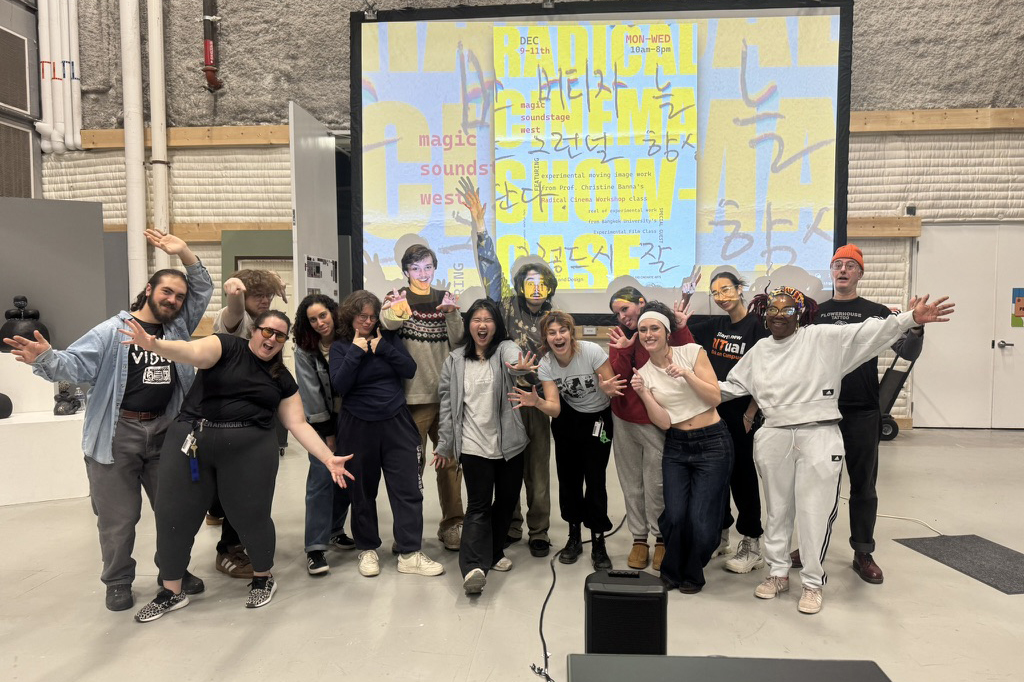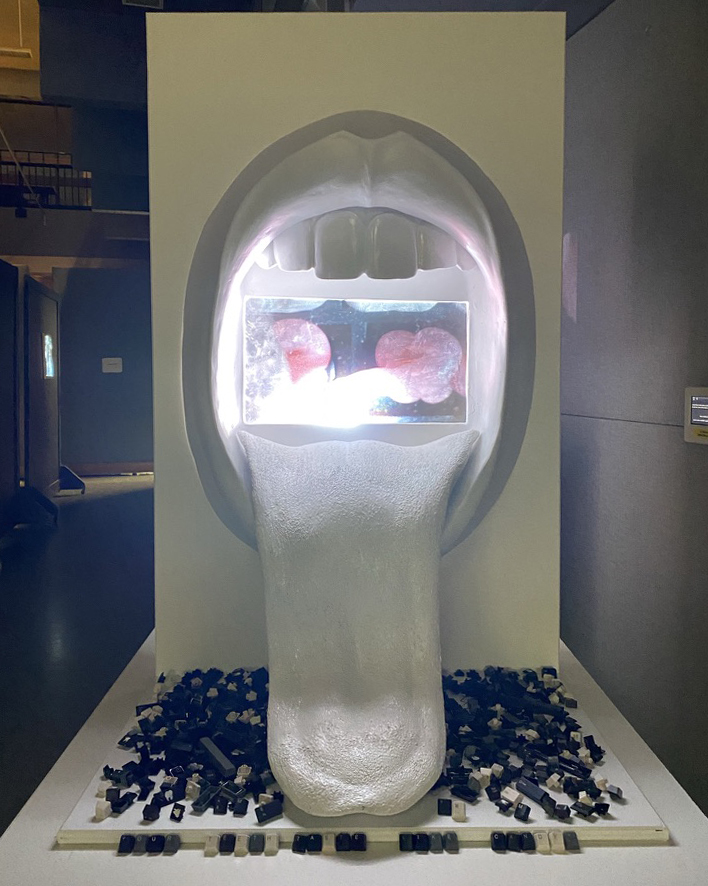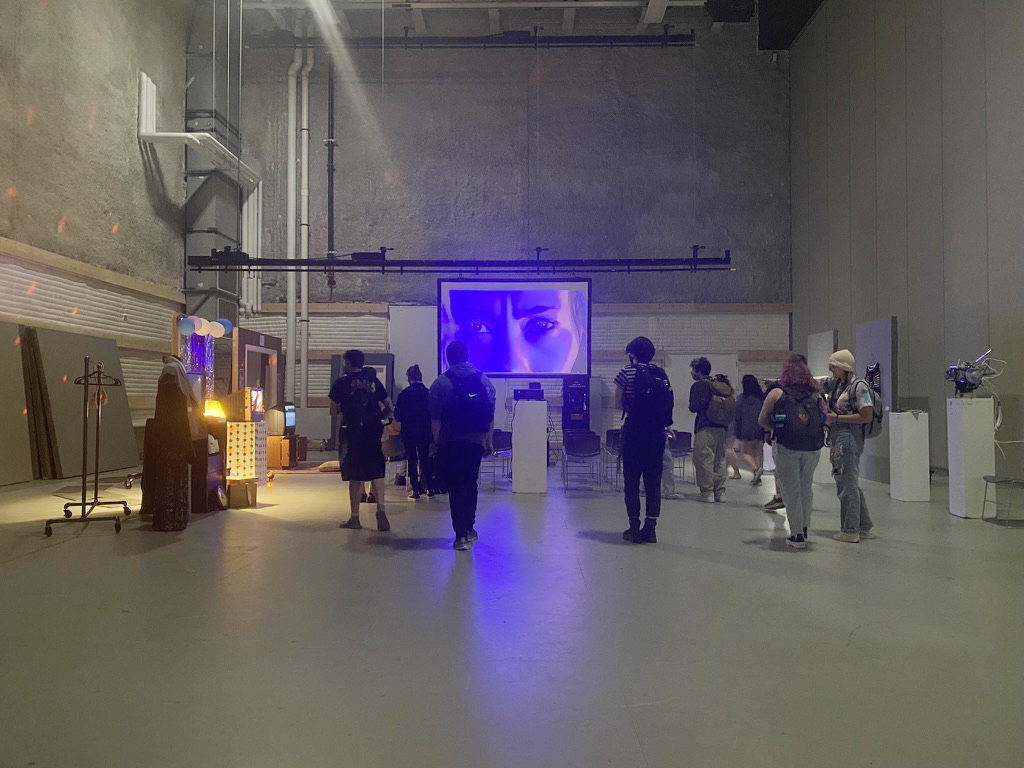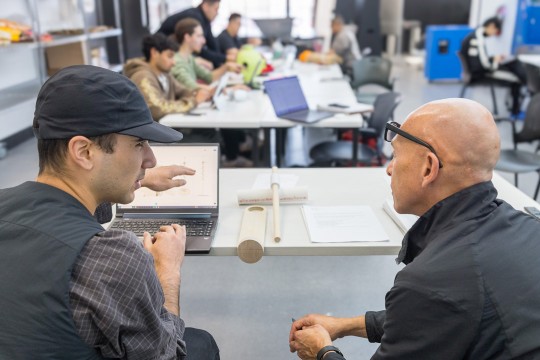Breaking the frame: Radical Cinema course pushes filmmaking limits
The fall 2024 Radical Cinema Workshop cohort in the MAGIC Spell Studios soundstage.
When thinking about filmmaking, many might default to a mental image of a large, rectangular screen in a dark room, where the audience takes the role of a passive viewer.
But Assistant Professor Christine Banna takes a different approach in her Radical Cinema Workshop course. The class focuses on experimental and alternative filmmaking methods and allows Banna, an accomplished animator, to teach both production and animation students with the goal of exploring and “working in the avant-garde.”
“I want them to find their own voice in filmmaking and take nothing for granted,” said Banna, who has taught in RIT’s School of Film and Animation since 2020. “That film doesn't have to be a rectangle. The moving image can be projected, it could be on a device, it could be multiple channels, it could surround you, it could be small, it could be large — there are literally no limits.”
Banna and Lecturer Jonathan Knight team up to teach the different sections of Radical Cinema Workshop every semester, culminating in a three-day, pop-up installation and experience in MAGIC Spell Studios. This semester’s showcase is set for 10 a.m.-8 p.m. April 28-30.
The first Radical Cinema Showcase in spring 2021 began as a collaborative way for Banna and her students to exhibit course output. Since that inaugural showcase in the Gannett Hall soundstage, where installations were distanced to comply with COVID-19 guidelines, the event has evolved into a popular end-of-semester destination in the MAGIC soundstage.
Question: How did you come to teach the Radical Cinema course?
Banna: “I felt like (coming to RIT) was my unicorn job because this is a job that hits my art history background and my love of video art, as well as being an experimental animator. It was the perfect fit. When I got here, I taught (Radical Cinema) for the first time in the spring of 2021.”
Madison Faraut '21
"your teeth taste like candy" by Madison Faraut from the first Radical Cinema Showcase in spring 2021.
Question: What inspired you to continue teaching Radical Cinema?
Banna: “I was really passionate about empowering students to call themselves artists. That first spring, there was a point where I got the hint that my students didn't consider themselves artists, and I asked them outright, ‘Do you consider yourselves artists?’ And most of the class said no. And these are students getting BFAs in film and animation. And you don't consider yourself artists? Why not?
“That opened up a whole can of worms as part of our conversation. I was honestly molding the class as I was teaching it that very first semester. I was adapting it to what my students needed, and what I noticed were severe gaps in their understanding of expanded cinema — cinema beyond the Hollywood industrial complex.”
Question: What does the term Radical Cinema mean to you?
Banna: “Radical Cinema basically just means not over-orchestrating the final product. It's process-driven art making, whereas in more traditional filmmaking, like narrative storytelling, the process is dictated by the product. In radical and experimental filmmaking, it almost requires us not to know what the final output fully is. We could have hints of our intent, we could have hints of what it could possibly look like, but really, the process dictates it. So it's kind of a reversal of how they work everywhere else.”
Question: How do you feel Radical Cinema has impacted students’ experiences?
Banna: “I would have never anticipated how it would have evolved over the last five years. I've had students say their freshman year, they went to the shows and were inspired by what they saw their classmates making. That's been one of the most rewarding things.
“Sometimes we'll have some really beautiful reflections of the process and of the films with my students, just impromptu, not in a critique way. We'll sit down and reflect on what worked, what they want to take with them, what they're proud of, and it is such a beautiful end to a semester's worth of work.”
The Radical Cinema Showcase in spring 2022. The event has evolved over the years, growing from a spaced-out showcase in the Gannett Hall soundstage to the MAGIC Spell Studios soundstage.
Question: How might this work help set students up for future careers in film and animation?
Banna: “Thinking outside the box and working in the avant-garde — that freeform art-making that pushes the boundaries of what we're doing with the moving image — can always come back to inform the more mainstream. So even if your main goals are to go toward a more industry-focused career, working in more freeform ways can make you a better creative problem solver, even for more narrative-driven work and more character-driven work.”
Question: What would you like students to take away from Radical Cinema?
Banna: “I think this is a class that allows them to have almost a playground with filmmaking. And it complements the other classes they're taking. Oftentimes, what they do in Radical informs how they approach documentary or fiction filmmaking. I want students not to take anything as a given when it comes to filmmaking and know that both rules are important to learn, but you don't have to use them in every scenario.”
Festival and exhibition success
Numerous films and installations made in Radical Cinema have experienced great success beyond the classroom, including:
- Alexandra McDonald ’22 exhibited Amalgamate at the Ann Arbor Film Festival and was recognized at Imagine RIT
- Elaina Couse ’24 created “!” won Best Experimental Short Film at the Albany Film Festival in addition to being an official selection for a handful of other festivals
- Aybüke Yilmazer ’25 MFA won Best in Cinematic Poetry/Video Art Chroma Art Film Festival for Video Art
- Colin O’Brien ’25 exhibited an interactive experience at Imagine RIT where visitors cued a visual synthesizer with each keyboard key that was pressed









